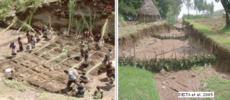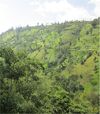Micro-hydro Power (MHP) Projects - Mitigation and Intervention Techniques - Soil Fertility Management and Biological Soil Conservation
From energypedia
Revision as of 14:47, 8 April 2015 by ***** (***** | *****)
Overview
► Back to the overview "Mitigation and Intervention Techniques Related to Micro-hydro Power (MHP) Projects"
Soil Fertility Management and Biological Soil Conservation
Compost Making
| Objectives: To promote compost making at household level for cost-effective soil fertility improvement and to support local level compost entrepreneurship linked to natural resources management activities at watershed level. CM will improve soil fertility, increase water storage within the soil profile and reduce surface runoff, thus reduce soil erosion. It is one of the best “hidden” water harvesting methods available (compost absorbs water 4-7 times its own weight). CM can be undertaken at very large scale and linked to area closure management and the upgrading of terraces into “cash crop production belts”. CM can become a business: groups of households (landless, etc.) can decide to become compost makers and provide “fertilization” services to other farmers. |
Fertilization and Manuring
|
Live Check Dams
| Objectives: Live check-dams are established by planting/seeding or plugging of cuttings in gully bottoms to replace or reinforce physical check-dams. The main objective of the establishment of live check-dams is to reduce the cost of establishing physical check-dams. Live check-dams can be applied by individual farmers and does not need the organization of a large group of people to undertake physical structures. |
Mulching and Crop Residues Management
|
Grass Strips along the Contours
| Objectives: Grass strips are vegetative barriers made out of grass planted in narrow strips of 0.5 to 1.5 m width laid out along the contour. Grass strips control erosion rather effectively in gentle slopes but above 5-8% slope their effect decreases. While contributing to protect soils against erosion they also provide valuable biomass meant to increase animal feed or used for different purposes (eg. roofing, etc.). Grass strips cause less interference than other measures as they can easily be crossed by oxen and plough. Moreover, grass strips take out little amount of arable land. Cost of construction is much lower than physical structures. |
Stabilization of Physical Structures and Farm Boundaries
|
Vegetative Fencing (VF)
|
Ley Cropping
| Objectives: Ley cropping is a cropping system in which legume based pastures are rotated with purely grown crops. Legume based pastures are grown on fallow lands for a few years to improve fertility of the soil and thus the yields of subsequent crops (mainly cereals). The establishment of dense, productive forage crops during the fallow period (1-3 years) provides a thick ground cover, supply forage of good quality after the rainy season, prevent soil erosion, restore soil fertility quicker than bare (and overgrazed) fallow, increase the water holding capacity of the soil and have a beneficial effect on future crop yields. |
Integration of Food/Feed Legumes into Cereal Cropping Systems
|
Intercropping
|
Crop Rotation
| Objectives: Crop rotation is one of the oldest practices known to man for fertility restoration and pest/ disease control and it consists of growing different crops one after the other on the same piece of land. Plants of the same crop develop their roots at the same depth of soil profile and thus the proliferation of the root systems in the same depth results in a strong competition for moisture and nutrients. Therefore, if the same crop is grown on the same land year after year, the soil nutrient in that layer decreases sharply and the crop yield consequently declines. On the other hand, if different crops are rotated, the depletion of soil nutrients and decline of crop yields are not as serious as when the same crop is grown year after year. Different crops have different characteristics that enable them to exploit the soil at different depths. Crops also differ in terms of their effect to the soil. Some crops restore or build fertility while others deplete fertility. |
Strip Cropping
| Objectives: Strip cropping is a cropping practice where strips of two or more crops are alternately established on the contour or, it is a system of establishing more than one crop in alternate strips following a contour pattern for the purpose of erosion control, crop diversification, and decrease the risks associated to the use of single crops only. This cropping system is designed as a defence mechanism against soil erosion in areas where the cropping system is dominated by row/sparsely growing crops that exposes the ground to erosive forces. For instance, crops like sorghum and maize are susceptible to erosion and need to be grown alternately with soil conserving crops. |
Further Information
References
- DESTA, L. et al. (2005): Part 1: Community Based Participatory Watershed Development: A Guideline. Addis Ababa: Ministry of Agriculture and Rural Development.
























